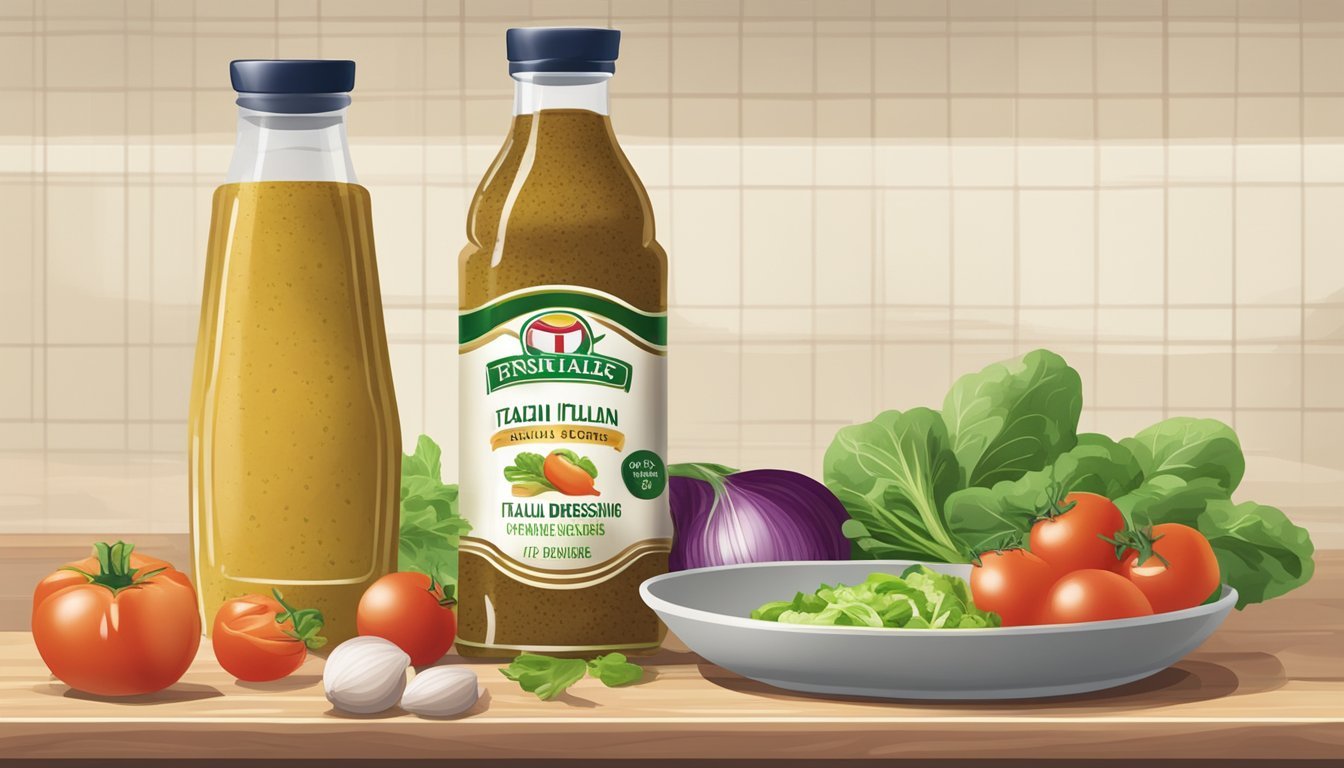Can Diabetics Eat Italian Dressing?
Understanding Ingredients and Health Impacts
Italian dressing, a popular choice for many salads, raises important questions for individuals managing diabetes. Yes, diabetics can eat Italian dressing, but they must be mindful of the ingredients and portion sizes. Key considerations include the carbohydrate content and potentially hidden sugars that could affect blood sugar levels.
Italian dressing is typically an oil and vinegar-based dressing, often flavored with herbs and spices. This makes it a generally good option for those looking to avoid the creamy, high-carb dressings that can spike glucose levels. Checking labels for added sugars and sodium content is essential, as some commercial varieties may include these in higher amounts.
Homemade Italian dressing allows for better control over the ingredients, ensuring it remains a diabetes-friendly option. Simple recipes combining extra virgin olive oil, red wine vinegar, garlic, and herbs can offer a delicious and safe alternative. Monitoring the serving size remains crucial to maintaining stable blood sugar levels.
Understanding Diabetes and Nutrition
Diabetes management requires careful attention to diet and nutrition, particularly in relation to carbohydrates and fats. This section examines the impact of these elements and emphasizes making informed choices when selecting foods like Italian dressing.
Role of Carbohydrates in Diabetes
Carbohydrates significantly affect blood sugar levels. When consumed, carbohydrates break down into glucose, which enters the bloodstream. For people with diabetes, it is essential to monitor carbohydrate intake to prevent spikes in blood sugar.
Foods with high carbohydrate content can lead to an increase in glucose levels. Therefore, it's beneficial to focus on foods that are low in carbs but high in fiber, which helps stabilize blood sugar levels.
Nutritional Profile of Italian Dressing
Italian dressing is typically made with oil, vinegar, and various herbs and spices. The primary source of calories in Italian dressing comes from fats, especially when made with olive oil, which is rich in monounsaturated fats.
A common serving size (about 2 tablespoons) contains approximately 80-120 calories, 7-12 grams of total fat, and minimal carbohydrates. It is also low in sugar, making it a favorable choice for those managing diabetes. However, sodium content can vary, so it's important to check the nutrition facts.
Health Implications of Fats and Sugars
Fats and sugars in the diet can impact heart health and blood sugar management. Monounsaturated fats, found in olive oil-based dressings, are heart-healthy and can improve cholesterol levels. In contrast, saturated fats and added sugars can elevate blood cholesterol and increase the risk of heart disease.
Choosing dressings with healthy fats and minimal added sugars helps manage blood sugar levels and supports overall cardiovascular health.
Balancing Diet and Diabetes Management
Effective diabetes management involves balancing meal plans to include nutritious foods while controlling portions. Low-carb, high-fiber foods should be prioritized to aid in maintaining stable blood sugar levels.
Including healthy choices, like Italian dressing made with olive oil, can enhance the flavor of meals without adversely affecting glucose levels. Portion control is crucial to avoid excessive calorie and fat intake.
Label Reading and Salad Dressing Selection
When selecting salad dressings, reading the nutrition facts is essential. Pay attention to serving size, total fat, calories, sodium, and added sugars. Opt for dressings with healthier fats and lower sodium content.
Look for labels that list ingredients like olive oil and avoid those with high amounts of preservatives and saturated fats. Choosing a dressing with fewer added sugars and lower sodium can make it a better option for diabetes management.
Components of Italian Dressing
Italian dressing is popular for its tangy flavor, achieved through a combination of oils, vinegars, and seasonings. This section explores its common ingredients, the various types and additives, and healthy alternatives to make it suitable for different dietary needs.
Common Ingredients in Italian Dressing
Italian dressing typically contains a mix of olive oil, vinegar, and herbs. The dressing usually includes:
Vinegar: Common types used are red wine vinegar, apple cider vinegar, and balsamic vinegar.
Olive Oil: Often extra virgin olive oil for its health benefits.
Garlic: Provides a robust flavor.
Lemon Juice: Adds a fresh, acidic note.
Dijon Mustard: Acts as an emulsifier.
Herbs: Typically oregano and basil.
Salt, pepper, and sometimes a bit of honey or sugar are also added to balance the flavors.
Variants of Italian Dressing and Additives
Besides the classic vinaigrette style, creamy versions also exist. These might include ingredients such as cream or mayonnaise. For those looking to avoid preservatives and artificial flavors, checking the labels is crucial as many store-bought dressings include these.
Some variants might also include added sugar, which is particularly important for diabetics to note. Additionally, homemade versions can easily be modified to suit personal tastes by adjusting the types and proportions of herbs and oils used.
Healthy Alternatives and Substitutions
For those seeking healthier options, natural ingredients and healthy oils are key. Using extra virgin olive oil instead of more processed oils can provide additional heart-healthy monounsaturated fats. Combining vinegar with lemon juice or lime juice can enhance the flavor profile without adding calories.
To avoid added sugars, consider sweetening with a small amount of honey if needed or omitting sweeteners altogether. Fresh herbs like basil and oregano can replace dried versions for a fresher taste and higher nutrient content. These alternatives ensure that the dressing remains flavorful while being better suited for those managing diabetes.
Implications of Italian Dressing for Diabetics
Italian dressing, commonly made with olive oil, vinegar, and various herbs, can be a suitable option for diabetics if chosen and consumed wisely. Key considerations include the glycemic impact, appropriate dressing choices, and portion control.
Glycemic Impact of Dressings
Italian dressing typically has a low glycemic index due to its primary ingredients, olive oil and vinegar. These components do not cause significant blood sugar spikes. Olive oil is mostly comprised of monounsaturated fats, which can help stabilize blood glucose levels. However, some commercial Italian dressings may contain added sugars or high-fructose corn syrup, increasing the carb content and potentially impacting blood sugar negatively.
Diabetic-Friendly Dressing Choices
When selecting an Italian dressing, diabetics should look for sugar-free or low-carb options. Reading nutritional labels is essential. Brands that list olive oil and vinegar as the first ingredients are usually better choices. Homemade Italian dressing is another viable option, using ingredients like extra virgin olive oil, red wine vinegar, and herbs. This approach ensures control over ingredients and avoids unwanted carbohydrate content.
Portion Size and Blood Sugar Control
Even with a diabetic-friendly dressing, portion control is crucial. A typical serving size is 2 tablespoons. Measuring out the dressing can help manage carb intake and prevent excess calories. For those monitoring their blood sugar levels, it can be beneficial to keep track of how different portion sizes impact their glucose readings. Keeping portions consistent can assist in maintaining steady blood sugar levels.
Monitoring the glycemic impact, choosing low carb options, and controlling portion sizes are all critical for incorporating Italian dressing into a diabetes-friendly diet.
Making Smart Choices
Selecting the right salad dressing is crucial for diabetics. Understanding key ingredients, nutrition facts, and how to make homemade versions can help maintain healthy blood sugar levels.
Recommendations for Diabetes-Friendly Dressings
Vinaigrette dressings are often a good choice for diabetics. They tend to be lower in added sugars and unhealthy fats. Dressings like balsamic vinaigrette or those made with apple cider vinegar improve insulin sensitivity.
Opt for dressings with extra virgin olive oil as a primary ingredient, as it contains healthy fats which are beneficial for heart health. Always check for low total fat content and reduced sodium options. It's important to look for dressings labeled organic or without artificial additives.
Tips for Creating Homemade Dressings
Creating homemade dressings allows better control over ingredients. A simple vinaigrette made with olive oil, vinegar, a pinch of dried herbs, and garlic ensures no hidden sugars or unhealthy fats.
Using a blender or food processor can make the process quick and easy. For a creamy texture, consider using avocados, which add healthy fats. Add fresh herbs like cilantro or basil for extra flavor. Adjust the serving size carefully to manage carbohydrate intake effectively.
Understanding Salad Dressing Labels
Reading nutrition labels is critical in making informed choices. Check the ingredients list for sources of added sugars or unhealthy oils. Focus on the nutrition facts label to monitor total fat content, sodium content, and serving size.
Brands often use misleading labels; ensure all ingredients align with a healthy diabetic diet. Look for total carbohydrates per serving and avoid those with high levels of added sugars. Ingredients should be simple, whole foods without preservatives or artificial colors. Monitoring these details helps in selecting a nutritious, diabetes-friendly salad dressing.
Conclusion
Italian dressing can be a suitable option for those with diabetes, provided certain factors are taken into account. Monitoring the ingredients is essential, as some store-bought versions may contain added sugars and unhealthy fats which could affect blood sugar levels.
Homemade Italian dressing is a healthier choice. It allows for control over the ingredients, ensuring a better balance of healthy fats and minimal sugar. A typical recipe might include ingredients such as extra virgin olive oil, vinegar, garlic, and herbs.
Benefits:
Low in Carbs: Many Italian dressings have a low carbohydrate content, beneficial for managing blood glucose levels.
Healthy Fats: Using olive oil provides monounsaturated fats, which are heart-healthy and can assist in optimal blood lipid levels.
Salad Recipes: Adding a diabetic-friendly Italian dressing to salads with non-starchy vegetables, lean proteins, and high-fiber components can make for a balanced meal.
It is important to always read the nutritional labels of commercial dressings. Some may contain hidden sugars or high sodium levels, potentially harmful to individuals managing diabetes.
Adopting homemade options can support better health management and maintain delicious flavors in meals.
Making informed choices about the ingredients and preparation methods used in Italian dressings can significantly contribute to a healthy diet for individuals with diabetes.
Appendix
This section provides essential information on Italian dressing recipes suitable for diabetics, substitutes for common ingredients, and a nutrition fact sheet for common dressings.
Italian Dressing Recipes for Diabetics
Creating a diabetes-friendly Italian dressing is straightforward with the right ingredients. A simple vinaigrette can be made using extra virgin olive oil, apple cider vinegar, lemon juice, and a touch of honey or artificial sweetener for sweetness.
An example recipe includes:
2 tablespoons extra virgin olive oil
1 tablespoon apple cider vinegar
1 teaspoon lemon juice
1 teaspoon honey or stevia
1/4 teaspoon garlic powder
Pinch of salt and pepper
Whisk the ingredients together and adjust the seasoning as needed. This dressing is low in carbs and suitable for diabetics due to the minimal sugar content.
Substitutes for Common Ingredients
When modifying Italian dressing for diabetics, some common ingredient swaps can significantly reduce sugar and fat content. Use Greek yogurt instead of sour cream or mayonnaise for a creamy texture with fewer calories.
For oil, avocado oil or sesame oil can replace traditional oils, providing healthy fats without adding carbohydrates. Those who prefer a bit of sweetness can replace sugar with artificial sweeteners or natural options like honey sparingly. Vinegar can be varied as well, with apple cider vinegar or balsamic vinegar adding unique flavors without impacting blood sugar levels.
Nutrition Fact Sheet for Common Dressings
Understanding the nutrition content of popular salad dressings can help manage diabetic needs effectively.
Dressing Type Calories Carbs (g) Fat (g) Sodium (mg) Italian (Homemade) 80 1 8 75 Caesar Dressing 160 9 15 320 Ranch Dressing 140 2 14 260 Thousand Island 130 4 12 240 Honey Mustard 120 8 10 280
The homemade Italian dressing provides a healthier alternative with lower carbs and moderate fat content. It's crucial to read the ingredient list carefully and adjust portions to maintain a balanced diet, especially for individuals managing diabetes.
Glossary of Terms
Understanding the terminology related to diabetes and salad dressings is crucial for making informed dietary choices. This section provides a breakdown of key dietary concepts, common ingredients and their impacts, and the different types of salad dressings and their characteristics.
Key Dietary Concepts for Diabetes
Carbohydrate: Nutrients that break down into glucose in the body, affecting blood sugar levels. Diabetics should monitor their intake to manage glucose levels.
Blood Sugar Levels: The amount of glucose present in the blood. Maintaining stable levels is crucial for diabetics to avoid complications.
Fiber: A form of carbohydrate that the body cannot digest, beneficial in regulating blood sugar.
Monounsaturated Fat: Healthy fats found in nuts, avocados, and oils. These can improve heart health and should be included in a diabetic-friendly diet.
Saturated Fats: Fats found in animal products and some plant oils. Consuming too much can lead to heart disease, which is a risk for diabetics.
Common Ingredients and Their Impact
Vinegar: Common in vinaigrettes, it can improve insulin sensitivity and lower blood sugar levels.
Garlic: Often used for flavor, garlic can provide health benefits, including potential reductions in blood sugar levels.
Mayonnaise: A base for many creamy dressings. It can be high in fats and calories.
High Fructose Corn Syrup and Table Sugar: Often found in unhealthy bottled salad dressings. Both raise blood sugar levels quickly and should be avoided.
Artificial Sweeteners: Used to replace sugar without raising blood glucose, although some may prefer to avoid them due to potential health concerns.
Sodium and Salt: Excess can increase blood pressure, a concern for diabetics who are at risk of heart disease.
Salad Dressing Types and Their Characteristics
Vinaigrettes: Made with vinegar and oil, often lower in calories and sugars. Suitable choices include balsamic vinaigrette, which can add a tangy flavor.
Creamy Dressings: Include options like ranch or Caesar. Often higher in fats and sugars, making them less ideal for diabetics.
Yogurt-Based Dressings: Often marketed as healthier options since yogurt can reduce the fat content compared to mayonnaise.
Sugar-Free Dressings: Specifically formulated to avoid added sugars. Brands like Bolthouse Farms offer such options.
Unhealthy Bottled Salad Dressings: Typically contain high levels of sugars, artificial ingredients, and preservatives. Always check labels for ingredients like high fructose corn syrup.
Resources
Diabetics seeking information about Italian dressing and diabetes management can find guidance from professional sources, community support, and educational literature. These resources offer practical advice on integrating healthy eating habits and managing blood sugar levels.
External Guides and Support for Diabetics
For those living with diabetes, external guides and support communities can be helpful. Websites such as Diabetes Meal Plans provide tailored recipes and meal plans that cater to individuals with type 2 diabetes. These resources often include comprehensive nutrition facts, helping readers understand the impact of various dressings and foods on their blood sugar levels.
Support groups, both online and in-person, offer a space for diabetics to share experiences and tips. Engaging with these communities can provide moral support and practical advice, such as the benefits of using low-carb vegetable oils and herbs like thyme in dressings to improve heart health and stabilize blood sugar.
Professional Advice on Diabetes and Diet
Health professionals, including dietitians and certified diabetes educators, play a crucial role in diabetes management. They offer personalized advice based on individual health profiles, including blood sugar levels and the presence of heart disease. Consulting with a healthcare provider can clarify which ingredients to include or avoid in a diabetes-friendly diet.
Reading research and guidelines from reputable health organizations such as the American Diabetes Association can also be beneficial. These professionals and institutions provide evidence-based recommendations on incorporating Italian dressing and other low-carb options into balanced, nutrient-rich meals.
Further Reading on Healthy Eating Habits
For those interested in deepening their knowledge, there are numerous books and articles focused on healthy eating for diabetics. Titles like "The Diabetes Meal Prep Cookbook" provide practical recipes, including salad dressings that are both delicious and beneficial for blood sugar control.
Online platforms such as nutrition journals offer free articles on the latest research into diabetes and diet. These readings often emphasize the importance of including ample greens and vegetables in meals, highlighting how ingredients like mint can add flavor without adding unnecessary carbs.





